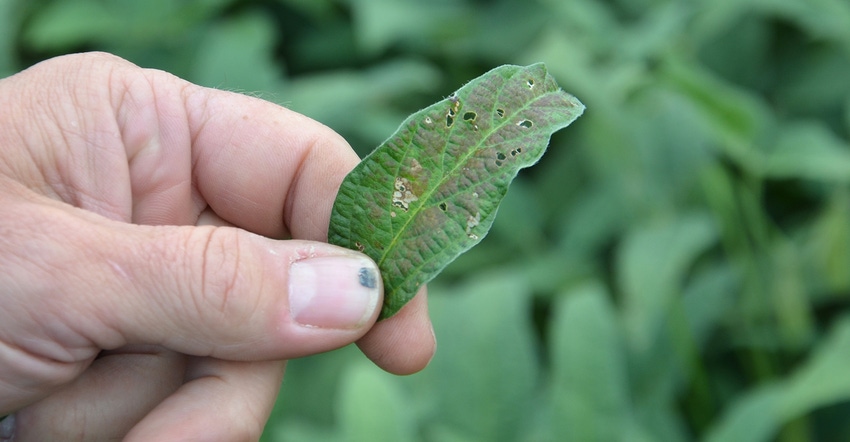
A good scout keeps a watchful eye on everything he or she sees while walking through a soybean field, Steve Gauck says. A wise scout can separate those things caused by weather, which the grower has no control over, from those things caused by a disease or insect feeding. A grower may be able to do something about diseases and insects — if not yet during the same growing season, possibly through management choices and planning during the off-season.
“We ran into a good example scouting the Soybean Watch ’20 field during early September,” Gauck says. He is a regional agronomy manager for Beck’s, based near Greensburg, Ind. Beck’s sponsors Soybean Watch ’20.
Related: Here’s an example of why drone scouting pays
“We found a few leaves with some purple discoloration,” he says. “It was typically just a few leaves on any one plant, and only on a plant here and there.
“When you see purplish discoloration on leaves during the reproductive stage, your first thought is that it might be cercospora leaf blight. That is the organism that causes purple seed stain. While not a big player in disease loss, it impacts seed quality because infected seeds are purple.”
Closer look
Gauck carries the Purdue University Corn & Soybean Field Guide in his back pocket when scouting. You can access similar information through apps created by the Purdue Crop Diagnostic Training and Research Center — one for corn and one for soybeans. They’re available at nominal cost from the apps store.
Leaves infected by cercospora become dark red and leathery, and irregular purple lesions develop, according to the Purdue guide. Gauck noticed that while these leaves had purple discoloration, they didn’t feel leathery, and he didn’t notice any lesions.
“What we were seeing was a better fit with sunscald,” he explains. “The guide includes a description of sunscald under weather damage that can show up in soybeans.
“Sunscald is usually on upper leaves, and sometimes appears as more of a bronzing of the leaves. That matched much better with what we were seeing.”
Sunscald occurs most often when there are mornings with dew followed by sunny days. In this case, there was a stretch with dew and high humidity, followed by drier conditions. In fact, the grower was irrigating the field when Gauck visited. If it’s dry, he continues irrigating until leaves are fully yellow and he is confident that beans within pods are mature.
“It’s possible that moisture from irrigation could result in sunscald symptoms over time, if there is a period of sunny days,” Gauck says. “It may have contributed to what we saw.”
The important thing to note is that sunscald shouldn’t impact yield. It only affects a small percentage of leaves, and doesn’t cause plants to die prematurely, Gauck says. There is no need for a management change.
If the symptoms had turned out to be cercospora, the Purdue guide outlines management steps for the future. They include selecting resistant seed, using a seed treatment effective against the disease and rotating out of soybeans to reduce inoculum buildup.
About the Author(s)
You May Also Like




